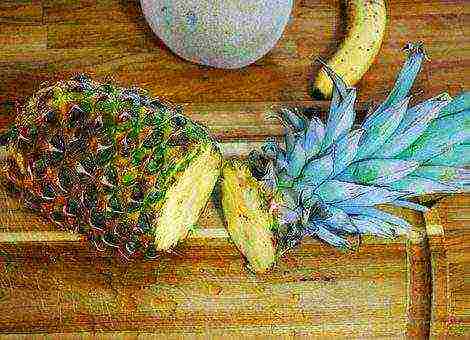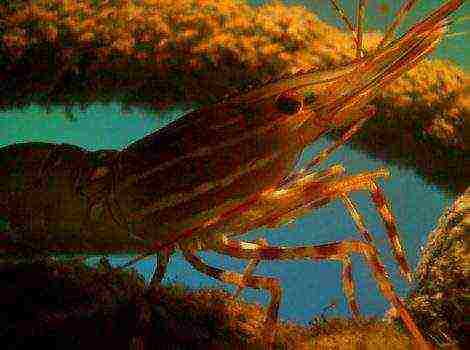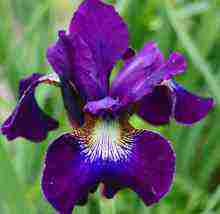Content
- 1 About chanterelle mushrooms
- 2 How to grow chanterelles at home
- 3 Planting material
- 4 How to breed chanterelles from laboratory mycelium?
- 5 How to breed chanterelles if there are no necessary trees in the yard?
- 6 Valuable properties of chanterelles
- 7 How do chanterelles grow in the forest?
- 8 The choice of planting material
- 9 Spore methods of sowing chanterelles
- 10 Sowing chanterelles with mycelium
Absolutely unusual, yellow-orange chanterelle mushrooms, arouse interest with their positive species and rich taste among gourmets and mushroom growers.
More and more people who are fond of cultivating crops are interested in how to grow chanterelles at home, on their plot or dacha, and whether artificial cultivation of these mushrooms is possible. Due to the structural features of the chanterelle mycelium, breeding them outside of natural conditions is a complex process that requires a lot of effort and attention.
About chanterelle mushrooms
Chanterelle mushroom (Cantharellus) belongs to the mycorrhizal family. This means that its mycelium can only exist in the vicinity of the roots of certain trees. Thin filaments (hyphae) of the mycelium, which are the "body" of the mycelium, are connected to tree roots. This union is by no means parasitic.
The mushroom gives the tree some of the nutrients, and from the roots it receives moisture and some of the elements it needs. This interaction is called symbiosis. Plants do not destroy, but complement each other. The existence of the chanterelle mycelium is impossible without the root system.
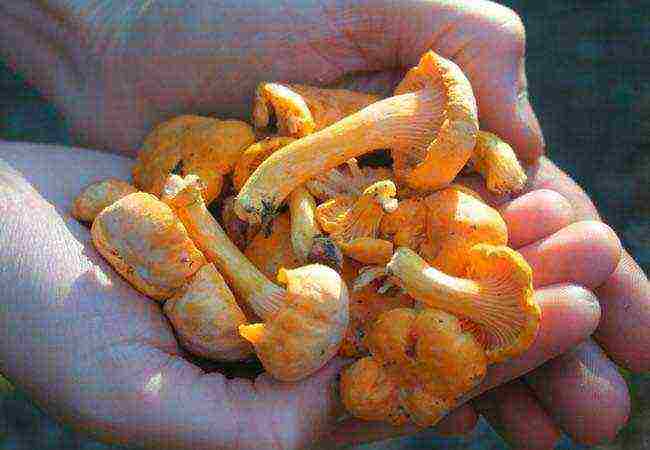 Chanterelles at home
Chanterelles at home
Externally, chanterelle mushrooms have a bright dark yellow or orange cap of a depressed appearance with carved edges, similar to the combs of a rooster. Among the people, the chanterelle is sometimes called "cockerel" precisely because of the structure of the hat. The diameter of the mushroom hat can reach 8-10 cm, the leg length is 5-7 cm. The leg forms a single whole with the mushroom head and does not have significant differences in color.
Best of all, chanterelles take root with pines, but they can coexist with oak, spruce, beech, fir. The chanterelle can grow in soils that are not particularly rich in nutrients and moisture, because it still takes the lack of elements from the roots.
To date, biologists have not been able to fully cultivate the chanterelle. The mushroom cannot be grown in completely artificial conditions, isolated from nature. Breeding of these myceliums can only be carried out on land plots on which suitable trees grow. No substrate, stumps, bars can become a breeding ground for a plant. "Cockerel" needs a symbiosis with living roots.
How to grow chanterelles at home
You can only grow chanterelles at home if the trees listed above grow on your site. At the same time, keep in mind that if the seed is taken from the mycelium under the spruce, then it must be planted under the spruce. The same applies to the rest of the trees and myceliums, otherwise the chanterelle will not take root. Seedlings can be made from the fruiting bodies of the fungus or take mycelium.
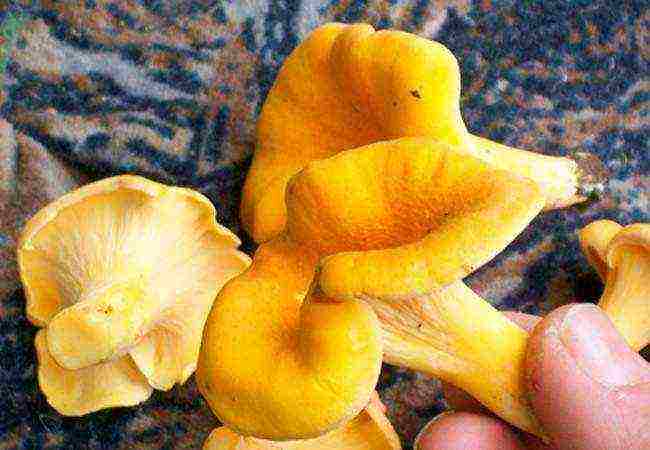 How to grow chanterelles at home
How to grow chanterelles at home
How to make seedlings from spores
Collect some mature large chanterelles in the forest. Rinse the hats, mash them into gruel and soak them in clean, preferably rainwater, for a day. The water should be sweetened, at the rate of 100 grams. sugar per 10 liters.
After a day, strain the water through cheesecloth or a fine sieve. It will be useful to water the land where the mushroom is planned to be planted with this water. The pulp that remains in the gauze (sieve) will serve as a seed for you.
How to plant
Chanterelles are best planted in spring or early summer when the weather is warm.
- Moisten the soil under the tree a few days before planting.
- On the day of planting, prepare 1 liter of saturated oak bark infusion.It is needed to disinfect the soil.
- Dig a small hole under the tree trunk, 50-60 cm in diameter and 20-30 cm deep.
- Pour oak bark over the hole and wait for the liquid to absorb. After about half an hour, put the seed from the mushroom gruel on the bottom of the depression, evenly distributing it throughout the pit.
- Bury a groove, slightly moisten the top of the soil.
Further, make sure that the soil in this place does not dry out. It should be kept hydrated, but not flooded with water. Humidity should be kept within 40%. For the winter, the mycelium should be covered with hay, moss or dry branches. The harvest can be expected next year.
Planting chanterelles from mycelium
Harvesting mycelium is best done in the fall. To get seedlings from the mycelium, find the chanterelle mycelium in the forest and dig a small area of soil under the tree. You will see that the earth is riddled with subtle hyphae. It is not necessary that the mycelium bears fruit at this moment.
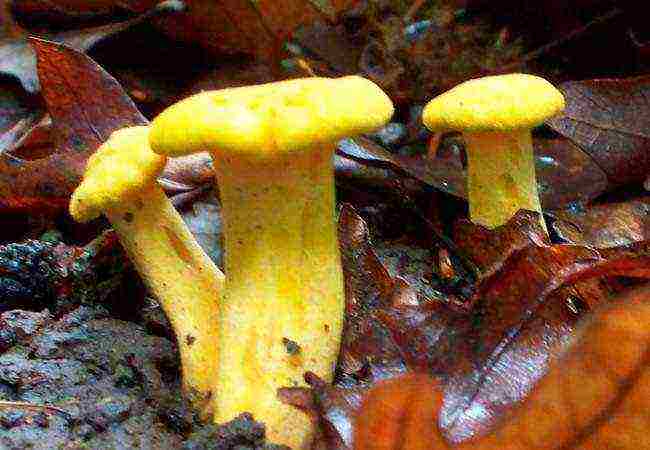 Planting chanterelles from mycelium
Planting chanterelles from mycelium
The mycelium must be kept until spring. It can be placed in bags and kept in a barn, basement, or any other cool non-residential area. The bags cannot be tied tightly, the mycelium must receive oxygen. Don't worry, the hyphae won't die even if the soil dries well. The mycelium can be vital for a year. Exposure is needed to destroy all harmful microorganisms that are in the soil. But mycelium must not be allowed to freeze, the best storage temperature is + 8-2 degrees.
In the spring, prepare the soil in your area in the same way as described above. Lay the soil with mycelium neatly in the dug holes. Cover it with soil, moisturize and care for, maintaining the necessary moisture level. Do not forget that you need to plant mycelium under the same tree species from under which it was taken. Harvest with a favorable outcome will be in a year.
 How to grow chanterelles at home
How to grow chanterelles at home
The technology of how to grow chanterelles at home is not so difficult. The point is that it takes a lot of patience to see the first harvest. But he may not ascend, due to the special nature of the chanterelles. These mushrooms have not yet been able to "tame" completely and control the process of their fruiting. Therefore, until now, no one takes up the cultivation of these mushrooms as a business. Growing chanterelles today can only remain an interesting hobby for summer residents and farmers.
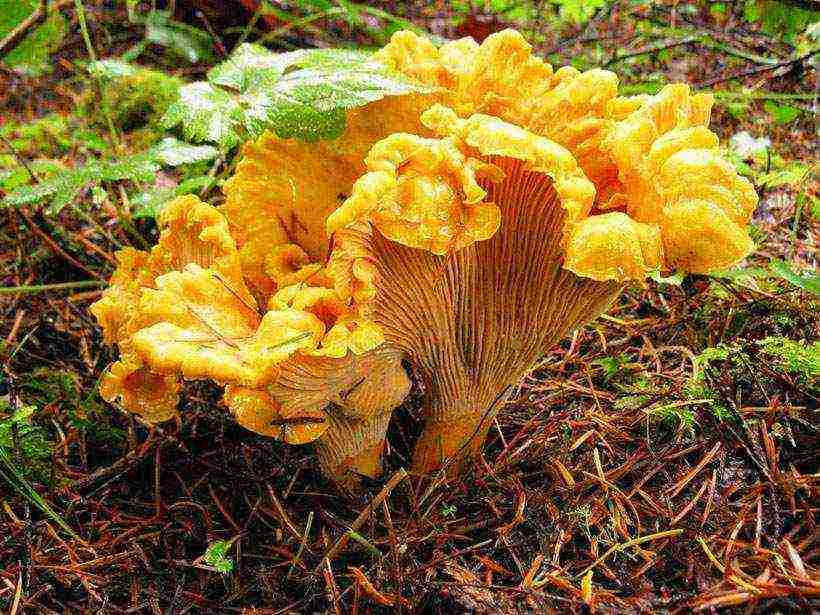
These mushrooms have a high taste and are very beautiful. Their bright yellow "cockerels" are visible from afar, even an inexperienced lover of quiet hunting can find them in the forest. Avid mushroom pickers who want to get more crops are trying to master the cultivation of chanterelles at home.
People have already figured out the cultivation of oyster mushrooms, champignons, shiitake and other mushrooms. But chanterelles cannot be grown in artificially organized conditions. Plants of the mycorrhizal family, to which chanterelles belong, can exist only in close contact with tree roots. They participate in symbiosis - they receive nutrients from the roots, supplying them with moisture.
You can have a mycelium with brightly colored cockerels in your outdoor area. But these fruits cannot be grown in a greenhouse, basement or cellar. Best of all, "cockerels" feel under a pine, oak, spruce, fir and beech. The presence of these trees on the site is the main condition for the cultivation of chanterelles.
Planting material
To grow chanterelle mushrooms, like any other, you need mycelium. You can purchase it in specialized stores, or you can get it yourself.
There are several options for "contaminating" the soil with chanterelle spores:
- The first way is to collect ripe mushrooms in the forest. Soak the hats in a bucket of sweetened water for 10-20 hours. Add sugar to the solution, at the rate of 100 grams per 1 liter of water. After the specified time, the chanterelles must be kneaded with hands in water. Strain the resulting liquid.Do not pour out the solution, it will be needed, as well as the remaining gruel.
- On the site, choose a tree of the same species near which you collected chanterelles. Remove the top layer of earth around it. Disinfect the place under the mycelium with tincture of oak bark. Pour the spore water around the tree. Spread the mushroom porridge on top. Cover with earth. Next, you need to ensure that the place is constantly moderately humid.
- Even dried chanterelles are suitable for obtaining planting material. They should also be soaked for several hours. It is better to use rainwater for these purposes.
You will harvest the first crop of chanterelles only in a year. For the winter, the place for mushrooms should be covered with dry branches or hay. - The second way is to harvest mycelium. In the fall, find a place in the forest where chanterelles grow. Even if the mycelium is not bearing fruit at the moment, the seedlings will be suitable. It is necessary to dig a small area with a shovel. Choose a tree that you have in your yard. In the ground, you will see thin white threads, this is the mycelium of chanterelles. It must be kept until spring. To do this, place the soil with mycelium in bags and put it in a cool place, for example, a cellar. Do not close the bags tightly, you need a constant supply of air.
The temperature must not be allowed to drop more than -2 ° C. In such conditions, the planting material overwinters well, and harmful organisms that could get into the soil from the forest will die. The earth can practically dry out during this time, but the mycelium will be in good condition. When it gets warm, in the spring, lay out the soil with mushroom threads around a certain tree, having previously cleared and disinfected the soil with a decoction of oak bark. Monitor the moisture content of the mycelium and in a year you will see the desired, bright yellow fruits.
Unfortunately, there is no such thing as an intensive breeding method. Growing chanterelles in a greenhouse is impossible, she needs tree roots and natural temperature.
How to breed chanterelles from laboratory mycelium?
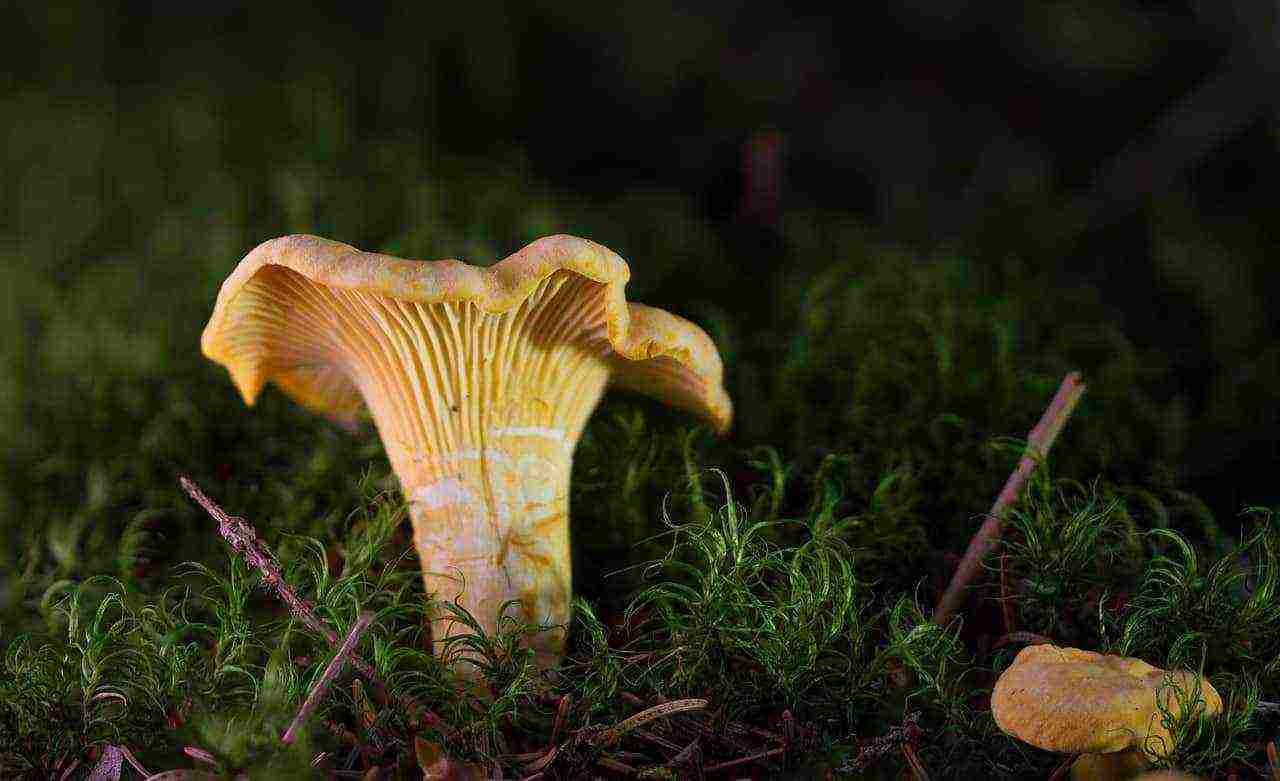
If you find the method of self-harvesting mycelium questionable, you can buy it. Today, chanterelle mycelium is available in specialized stores, and you can buy it on the Internet. Just be interested in the seller's reputation so as not to get caught on a low-quality product. The package must be accompanied by instructions that indicate how much mycelium must be applied per square meter of soil.
Growing chanterelles at home requires compliance with the following technology:
- Land must be brought from the forest.
- Choose a tree of an identical species - on the site and in the forest.
- The prepared laboratory mycelium is added to the prepared pits.
- Cover with earth, watered abundantly.
Further care for the mycelium is identical to the first two methods. It is enough to monitor the humidity and provide protection from frost in the cold season, covered with hay, straw or dry branches.
So chanterelle mushrooms are grown at home if there are trees of suitable species in the summer cottage. If there are none, do not be discouraged, you can think of something.
How to breed chanterelles if there are no necessary trees in the yard?
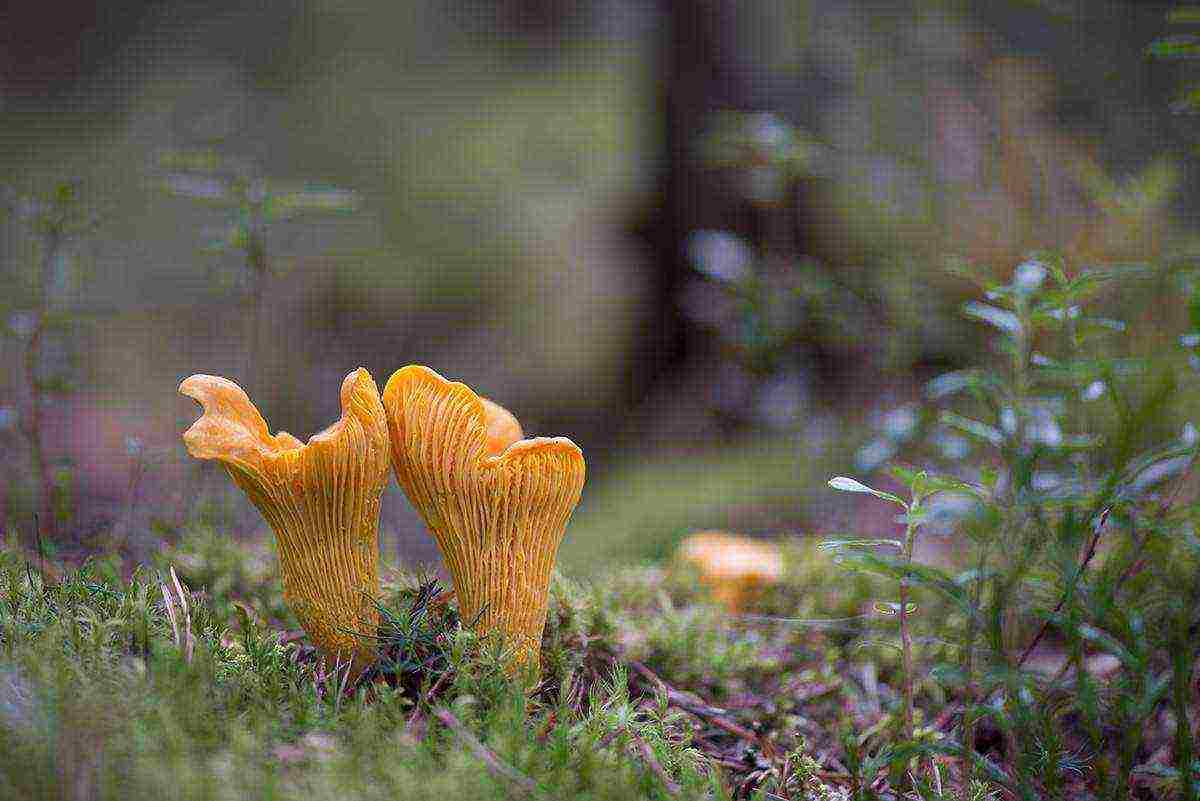
The answer to this question suggests itself. Trees need to be planted! And together with the chanterelles. This is done in the following way. A young oak, pine or alder is found in the forest, around which a family of chanterelles has already "settled". The tree is dug up so as to capture the soil with the mushrooms. The seedling is planted on the site, the moisture of the soil is monitored. In a year or two, you will be able to harvest chanterelles near your own home.
Despite the objective difficulties, growing chanterelles at home is quite possible. But today no one recommends doing this professionally, it is impossible to build a business on chanterelles, due to their dependence on their natural habitat.
Of all the species of valuable mushrooms, the chanterelle is most appreciated by mushroom growers and lovers of mushroom cuisine.These red-haired beauties contain many useful substances and have long been used in folk medicine. Many delicious Russian dishes are prepared from them.
More recently, chanterelles could be found in a forest belt near every city. But now there are much fewer of them, so the issue of home cultivation of this valuable breed is more relevant than ever.
Valuable properties of chanterelles
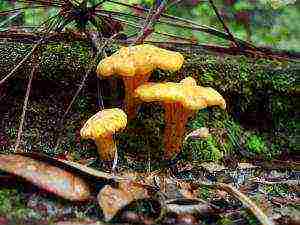
Lat. Cantharellus cibarius
In many regions, chanterelles are considered a valuable species of mushrooms. They have a pleasant aroma and delicious pulp. For this they are so adored by connoisseurs of Russian cuisine - chanterelles are good in any form. Marinated, fried, dried, salted, in scrambled eggs: each dish is wonderful in its own way thanks to the delicate mushroom taste of these ginger favorites.
The composition of mushrooms includes essential amino acids, vitamins and trace elements. They are also rich in beta-carotene, and therefore have their own bright carrot color.
The benefits of chanterelles in the treatment and prevention of hepatitis C, liver and eye diseases are known. For a long time, these mushrooms have been used to strengthen the immune system and suppress inflammatory processes in the dank season.
The folk craft of collecting saffron milk caps for sale can be very profitable in good years. Experienced mushroom pickers appreciate them for the fact that they are rarely affected by worms, and during transportation they retain their presentation, aroma, and freshness.
The peculiarities of breeding chanterelles are such that in the conditions of a personal plot it is hardly possible to get a large harvest from them. These are not champignons or oyster mushrooms, which have learned to grow on an industrial scale in huge quantities. But it is quite possible to provide your family with healthy and tasty red mushrooms for one season, you just have to find a suitable tree under which you can arrange a small mushroom plantation.
How do chanterelles grow in the forest?

Chanterelle harvest
Even an inexperienced mushroom picker will notice chanterelles in the forest thanks to their bright orange color and the unusual structure of the mushroom cap, wavy at the edges and smoothly turning into a thick leg. They always grow in families in shady, humid places, preferably on coniferous litters near pines and spruces.
The average diameter of their caps is 8 cm, and the length of the leg is 6 cm. However, not only red varieties of these mushrooms are found in nature, there are also gray chanterelles. They are gray in color and turn black when cooked, but they are also edible.
By the way of its life, the fungus belongs to the mycorrhizal species. This means that it forms mycorrhiza - an underground formation for symbiosis with a tree root. Chanterelle mycorrhiza grows deep into the ground and is in close contact with the underground parts of the symbiont tree. As a result of this interaction, mushrooms receive nutrients such as complex carbohydrates, phytohormones, and amino acids.
The benefit for the tree is to enrich its roots with moisture and obtain mineral components from the soil through mycorrhiza. Therefore, the families of these fungi are more often found in forests where the soils are not so fertile, but sufficiently moist.
In order to grow chanterelles at home on the site, you need to recreate as closely as possible the conditions in which they are used to developing in nature. And the main criterion for their good development is the presence of a forest tree in your garden. It does not have to be an old pine or spruce, mushrooms are found in the forest and at the foot of oaks and beeches.
The choice of planting material

First harvest of chanterelles
If you nevertheless decide to grow chanterelles at home, you need to be patient, since this process is quite long. The first harvest can be expected only a year or two after sowing. But the result is worth it, it remains only to choose the optimal method of planting chanterelles on the site. There are several of them, let's try to understand them and identify the advantages.
Any planting begins with the preparation of planting material, and mushrooms are no exception.The peculiarities of breeding chanterelles and the secret of their successful cultivation lie in the choice of the same type of tree, near which the planting material was taken.
You need to start, first of all, from the type of future symbiont tree that is in your garden, and then go to a nearby forest belt, where chanterelles can grow. Next, you should look for such a partner tree infected with mushrooms, which is on your territory. The choice should fall on a healthy, sturdy tree, all parts of which, from the trunk to the crown, will be green and without drying out areas.
In the form of planting material, you can use:
- Hats of old chanterelles.
- Spore infusion.
- Portions of top soil near a partner forest tree.
- The finished dug out mycelium.
The use of old hats, infusion of mushroom spores and a ready-made dug out mycelium does not require lengthy procurement of planting material. But the use of the top soil containing mushroom mycelium requires preparation for a year. However, it is this method that experienced mushroom growers advise to use, since its effectiveness is almost always equal to one hundred percent.
Spore methods of sowing chanterelles
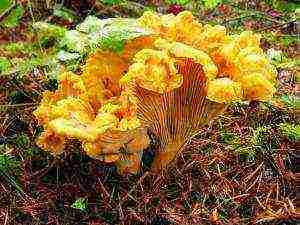
Chanterelles raised with spores
Like most mushrooms, the chanterelle can be planted by infecting the roots of the tree with spores or spreading fungal mycelium near the tree. Chanterelle spores can be obtained from mushroom caps or from a prepared infusion.
To harvest the caps of saffron milk caps, you need to go to the nearest forest belt and find the same tree there, which will be in symbiosis with them on your site.
If there are already myceliums with fruit bodies under the forest tree, you can safely cut off several caps from old overripe mushrooms. It is also recommended to bring along a small amount of the upper forest floor on which the chanterelles grew.
Hats from the forest should wither a little, and then they are laid out under a partner tree and covered with branches, leaves, and the top layer of litter brought from the forest.
Caring for chanterelles in this case comes down to maintaining constant soil moisture around the symbiont tree, since mushrooms love moisture, but waterlogging is also destructive for them.
You can go the other way, and prepare a spore infusion from these old hats:
- The hats are placed in a bucket of water, preferably rainwater. Add 50 g of sugar there.
- After a day, the caps are crumpled in water so that they are completely softened, and the solution is filtered.
At a darkened place under a tree, the top layer of earth is removed to a depth of 15 cm, with a diameter of about 1.5 meters. To kill unnecessary microorganisms in this area, which can compete with fungal spores, it is watered with a decoction of oak bark.
After 2 - 3 hours after that, the open area is watered with a decoction of chanterelle spores, and the mushroom pulp remaining on the gauze is placed on top of the open areas of the tree roots.
The hole is buried with removed soil and carefully watered along the trunk so as not to erode the soil with sowing.
Caring for a tree infected with fungal spores will consist of regular, moderate watering.
Already next summer, chanterelles will begin to grow near the partner tree.
Sowing chanterelles with mycelium
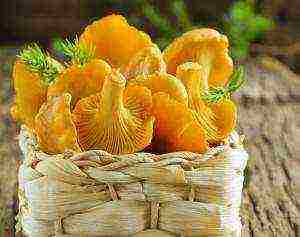
Chanterelles
Chanterelles can be propagated not only by spores, but also by ready-made mycelium, which is the smallest vegetative bodies of the fungus. Mycelium filaments are abundant in the soil around trees that have ever had chanterelles.
The fruiting bodies of the mushrooms themselves may not be visible on the surface, but myceliums always remain in the ground in order to develop at an opportune moment. The method of replanting with mycelium is recognized as the most reliable in the case of breeding chanterelles, although it may take longer before waiting for the first harvest.
The sampling of soil takes place in the forest located closest to the site, near the same tree, healthy in appearance. It is best to do this in mid-spring or late summer. Several such layers of soil are dug up, one shovel wide and 15 cm thick.Each earthen lump must be moved and transported carefully so as not to damage the mycelium filaments.
Then the soil fragment is divided into 5 - 10 parts and each is placed in a separate bag or box, but not covered, leaving access to oxygen. These containers with the ground are stored in a cool place for a whole year until June next year. Such exposure will only benefit the mycelium: they will become more viable, and all other microorganisms in the soil will die. But it is important not to overexpose this soil, since the mycelium is capable of germination only for 15 months.
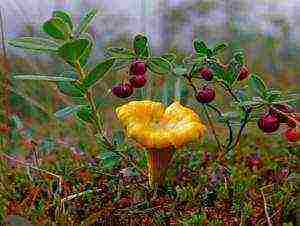
Chanterelles in the wild
In June next year, you can start planting. To begin with, you will need to dig holes around the partner trunk 20 cm deep. Dry soil with mycelium should be poured into these holes, tamping tightly. After planting, watered immediately, gently using the spray nozzle on the watering can.
Watering should be plentiful enough: there will be a liter of water for each hole, and at least 10 liters on the ground around them. It remains only to provide the plantings with a shelter in the form of branches, foliage, and a forest litter of needles taken with you is also suitable. Do not forget to water your mushroom plantings on time, especially in dry weather.
The appearance of families of red fungi can be expected next summer or even spring when the weather is favorable.
There is another interesting way to plant chanterelles in your garden using mycelium.
Suppose you do not have a suitable tree on the site that could become a symbiont for chanterelles. Then you should go to the forest and look after a young tree for yourself, but already infected with this fungus.
Having carefully dug up both the tree and the mushroom root, you can deliver them to the dacha and plant, as usual, plant seedlings. It is important to choose the right place for the forest guest: it must be sufficiently humid and free from direct sunlight.
While watching the video, you will learn about growing chanterelles at home.
When there is a desire, it is quite simple to grow chanterelles at home in the garden. To master the technology of their breeding, you do not need to have special skills; a novice mushroom picker can also use it. Caring for chanterelles is also easy to perform, and the result will not be long in coming.
Have you noticed a mistake? Select it and press Ctrl + Enter to tell us.
Vegetables
This beautiful and tasty mushroom, which is never wormy, is adored by mushroom pickers and gourmets. It's always nice to see the bright red chanterelle hat peeking out of the moss. Chanterelles are dried and pickled, harvested fried and salted. They prepare soups and pies, add to porridge and stuff pancakes with them. But there is no dish tastier than fried chanterelles with potatoes and onions. Scrambled eggs with chanterelles are also a recognized delicacy.
 Common chanterelle
Common chanterelle
About the benefits of chanterelles
Chanterelle is rich in vitamins, minerals and amino acids. The bright red carrot color is due to the high content of useful carotene. The mushroom is used in the prevention of various diseases, in the treatment of liver, hepatitis C, eye ailments. The chanterelle helps fight inflammatory processes, inhibits the growth of many pathogens, and increases immunity. A couple of decades ago, it was an ordinary mushroom, widespread in our forests. Today, near large cities, the chanterelle has become a rarity, as well as other valuable mushrooms.
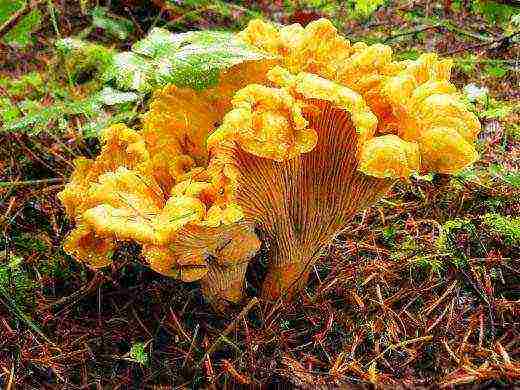 Chanterelle formosa
Chanterelle formosa
How to grow a chanterelle on the site?
Champignons and oyster mushrooms grown in large mushroom farms have long been familiar. Forest mushrooms are still not so common in industrial production, but skilled amateur mushroom growers successfully grow noble tubular mushrooms on their plots: boletus, boletus, boletus. The chanterelle, whose genus numbers up to sixty species, is an infrequent visitor to the gardens, but if you create the necessary conditions for it, it is possible to get a good harvest from your plot.
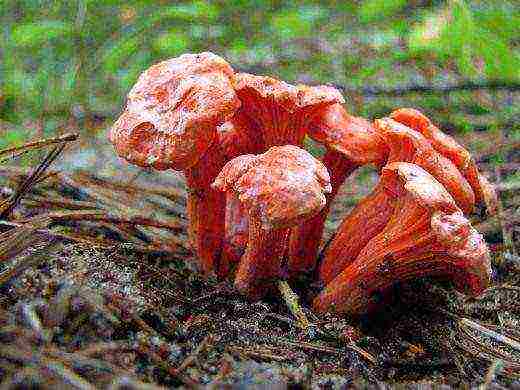
The chanterelle fungus forms mycorrhiza - the mycelium of the fungus grows into the root system of the tree. Mycorrhiza is a symbiotic formation, the plant supplies the fungus with nutrients, the mycorrhiza supplies minerals to the roots of the partner, improves the supply of moisture. The best partners of the chanterelle are pine and spruce, the mushroom can cooperate with oak, beech and some other types of trees. Attempts to "make friends" the forest mushroom with garden trees are doomed to failure.
So, we know the main condition, without which it is impossible to grow a chanterelle: the mushroom plantation should be located under the partner tree. If there is none, you will have to plant. It is better to choose a young tree in the mushroom forest, immediately with the mycelium. The mycelium is located at a distance of 15-20 cm from the surface, it is advisable not to destroy the fungus root. It is necessary to grab together with the tree a couple of bags of the upper layer of forest soil and coniferous litter. It is better to plant a forest tree with a mushroom root in a semi-shady place on the site. When planting, the mycelium should be in the forest soil, covered with needles on top. The mycelium does not tolerate both drying out and waterlogging, so moderate watering will have to be carried out regularly. There is no need to fertilize the soil: the chanterelle will receive nutrients from the partner's roots.
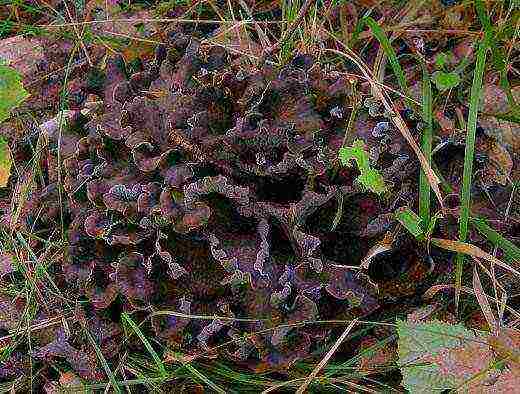 Chanterelle gray
Chanterelle gray
If a pine, spruce, or other forest tree is already growing on the site, chanterelles can be planted to it. Moreover, the spruce can be blue, and the mountain pine, the yield does not depend on the variety and subspecies of the tree. There are two methods: planting mycelium and sowing spores.
When sowing, choose the caps of old, overripe from a gastronomic point of view, mushrooms. Some amateur mushroom growers advise simply scattering the caps under the tree, others recommend soaking them in water, and after a day, having mixed well, pour the planting site with the solution. The main condition is to further maintain a constant humidity level: drying out or waterlogging will destroy the planting material.
 Chanterelle white
Chanterelle white
A more reliable and faster way is to plant mycelium dug out in the forest. Pits are dug under the symbiont tree, the depth is about 20 centimeters, the size in the plan is not important, but usually it is 15x15 cm.The mycelium is placed there together with forest soil, covered with moss, coniferous or leaf litter on top. The watering regime is the same as for spore planting. Planting times are from June to September. There is one subtlety: the mycelium must be prepared under a tree of the same species, which will serve as a symbiotic partner.
Subject to the above conditions, especially the humidity regime, by the beginning of June next year it will be possible to taste chanterelles from your own garden.
